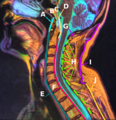Nuchal ligament
| Nuchal ligament | |
|---|---|
cervical vertebra 7 | |
| Identifiers | |
| Latin | ligamentum nuchae |
| TA98 | A03.2.01.006 |
| TA2 | 1678 |
| FMA | 13427 |
| Anatomical terminology] | |
The nuchal ligament is a ligament at the back of the neck that is continuous with the supraspinous ligament.
Structure
The nuchal ligament extends from the
From the
The trapezius and splenius capitis muscle attach to the nuchal ligament.
Function
It is a tendon-like structure that has developed independently in humans and other animals well adapted for running.
Clinical significance
In Chiari malformation treatment, decompression and duraplasty with a harvested nuchal ligament showed similar outcomes to pericranial and artificial grafts.[3]
Other animals
In sheep and cattle, it is known as the paxwax.[4] It relieves the animal of the weight of its head.
The nuchal ligament is unusual in being a ligament containing more elastin as well as collagen, allowing for stretch and recovery to its original form.[5] Other ligaments are made mostly of viscoelastic collagen fibers, a material two orders of magnitude stiffer, which cannot retain their original shape when extended past a certain point or for a prolonged period of time.[6][7]
Structurally, the nuchal ligament is formed with the association of both elastin proteins as well as type III collagen (45%). The collagen fibrils share a consistent size as well as helical pattern which gives the ligament its tensile strength. The elastin on the other hand is a protein that allows for flexibility. These two elements of the nuchal ligament maintain a complex balance which allows the constant weight bearing of the head along with multidirectional movement without damaging the durability of the ligament through over-use/stretching. [8]
In most other mammals, including the great apes, the nuchal ligament is absent or present only as a thin fascia.[2] As it is required for running, not all animals have one.[9]
All dogs (and all living Canidae - wolves, foxes, and wild dogs) possess a similar ligament connecting the spinous process of their first thoracic (or chest) vertebrae to the back of the axis bone (second cervical or neck bone), which supports the weight of the head without active muscle exertion, thus saving energy.[10] This ligament is analogous in function (but different in exact structural detail) to the nuchal ligament found in ungulates.[10] This ligament allows dogs to carry their heads while running long distances, such as while following scent trails with their nose to the ground, without expending much energy.[10]
In horses, the parasite Culicoides can spread onchocerca cervicalis by living in the nuchal ligament, causing dermatitis.[11]
Meat industry
In the meat industry, the nuchal ligament is referred to as paddywhack (also spelled pandywack; also called back strap or paxwax).[12]
The word is mentioned in a dictionary of South-west
Dried paddywhack is commonly packaged and sold as a dog treat,[12] hence the phrase, "Knick-knack, paddywhack, give the dog a bone" in the nursery rhyme, This Old Man [citation needed]. Paddywack is unpalatable as a human food because it cannot be softened or tenderised, but it makes a good natural dog chew.[15] It is classed as offal by the meat industry.[12]
Additional images
-
I: Nuchal ligament
-
nuchal linesare identified at left)
-
Microscopic image of the nuchal ligament.
See also
References
![]() This article incorporates text in the public domain from page 290 of the 20th edition of Gray's Anatomy (1918)
This article incorporates text in the public domain from page 290 of the 20th edition of Gray's Anatomy (1918)
- ISBN 978-0-443-06612-2.
- ^ a b Swindler, D. R., and C. D. Wood. 1973 An Atlas of Primate Gross Anatomy. Seattle: University of Washington Press[page needed]
- S2CID 4793248.
- ^ Merriam Webster Dictionary. Retrieved 4 October 2021.
- ISBN 0702047449.
- .
- PMID 36979509.
- PMID 1810923.
- S2CID 2470602.
- ^ a b c Wang, Xiaoming and Tedford, Richard H. Dogs: Their Fossil Relatives and Evolutionary History. New York: Columbia University Press, 2008. pp.97-8
- OCLC 865010322.
- ^ ISBN 978-1-909248-55-7.
- ^ "paxwax", Oxford English Dictionary Online, retrieved 10 October 2021 (subscription required).
- OCLC 249538445.
- ISBN 978-1-78879-395-7.[page needed]



